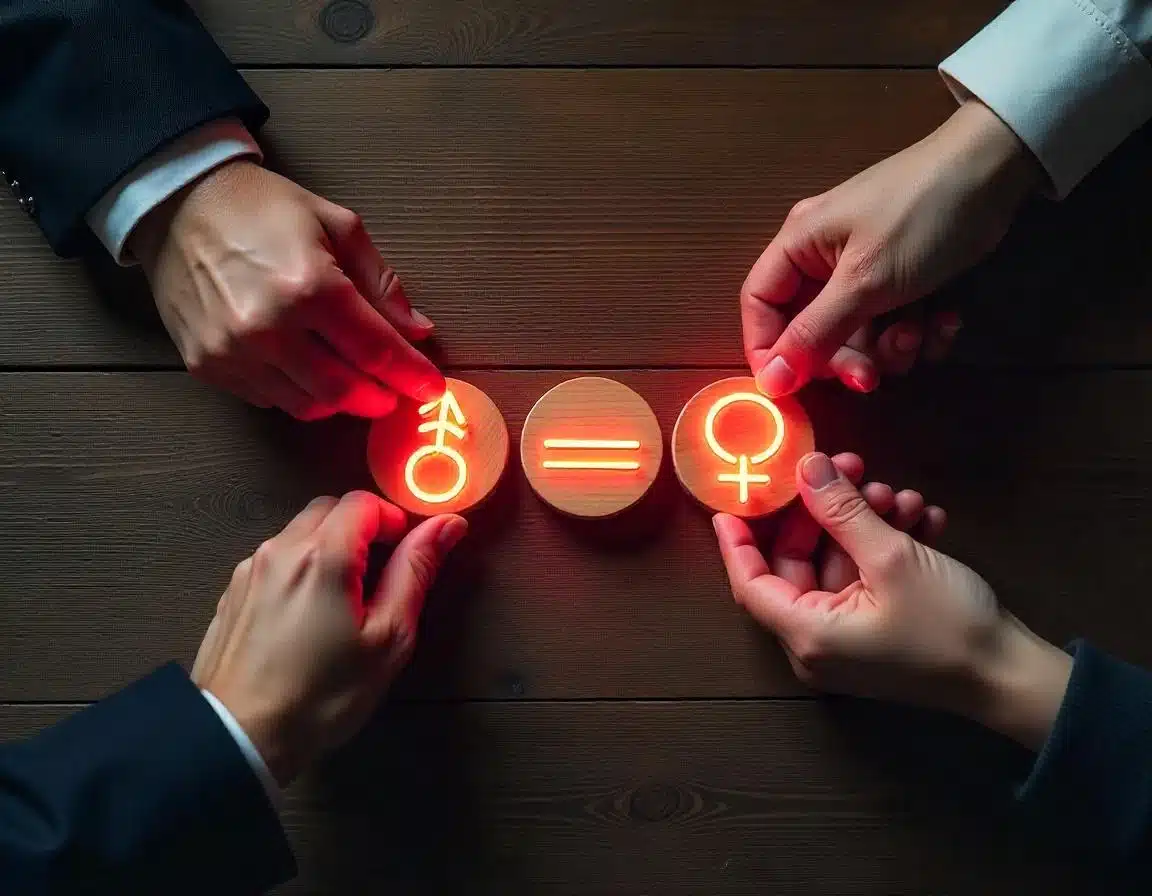We would like to believe gender discrimination in the workplace is a thing of the past. Unfortunately, workplace gender discrimination, whether conscious or unconscious, is still very much present in all industries throughout the country.
Toxic work cultures and discriminations continue to plague the workplace, making it hard for some people to be productive and achieve their expected career progress. However, there are things companies and organizations can do to help combat this problem.
This article will discuss what gender discrimination is, what types of gender discrimination exist, how to prove it happened in the workplace, and how to stop it from ever happening again at your place of work.
What is Gender Discrimination in the Workplace?
Gender discrimination in the workplace happens when an employer treats a potential candidate or current employee unfairly because of their gender. This form of workplace discrimination also includes unfavorable treatment because of gender identity, gender expression, and sexual orientation. Although sex discrimination has been predominantly an issue for women, men can also be victims of this form of discrimination.
Gender discrimination can happen while hiring, firing, determining raises and promotions, determining pay and benefits, and when an employer or employee creates a hostile work environment because of gender harassment. Any form of gender-based workplace discrimination violates federal, state, and local laws.
Although sex and gender are used interchangeably, gender discrimination refers to traits culturally associated with male or female identity, while sex pertains to anatomical identity. Gender discrimination can happen, for instance, when an employee identifies as transgender, and their employer or manager allows the employee to be harassed by colleagues due to their identification. Similarly, gender discrimination can occur when a qualified worker is not promoted because they are gay, and the employer has gay stereotypes. Firing an employee due to their gender transition can also constitute gender discrimination.
Types of Gender Discrimination in the Workplace
Gender discrimination doesn’t need to be deliberate. Someone in the workplace may be discriminating against an employee without realizing it or meaning to, however, this might still count as workplace discrimination. The anti-discrimination law doesn’t allow positive discrimination favoring one gender, however, positive action is legal and allowed. Aside from protecting both men and women from gender discrimination in the workplace, the law also protects workers from:
- Pregnancy or maternity leave discrimination;
- Discrimination due to gender reassignment (changing from one gender to another);
- Discrimination due to being married or being in a civil partnership;
- Discrimination based on gender expression or sexual orientation.
There are two types of gender-based discrimination at work – direct and indirect discrimination. Direct gender discrimination happens when an employee is treated less favorably because of their gender than an employee of the opposite gender would be treated in the same circumstances. Harassment and sexist abuse are also forms of direct gender discrimination. Indirect gender discrimination applies to situations when companies have a rule, policy, or practice in which an employee of one gender is less likely to meet, which places them at a disadvantage to the opposite gender.
Other forms of unlawful gender discrimination that people, mostly women, may face at work are:
- Hiring/Promotions/Firing – A person applies for the job for which they have experience and exceptional qualifications, but they are not hired because the company’s clients prefer dealing with men; A female employee is told they are being laid off due to cutbacks and reorganization, while men in the same position and with less seniority are able to keep their job; A female employee has been working for the company for years, receiving amazing reviews and/or employee-of-the-year awards, yet every time she applies for the promotion the position she applies for is taken by a less qualified man.
- Salary – A female employee has worked her way up in the company and is now a top salesperson for her organization. She finds out that a male employee with similar training and work experience has been recently hired and will be paid more than her. She is moved to a less desirable work territory while a male employee with lower sales numbers is given her territory and client base.
- Job Classification – A woman who has worked for years in the company, putting in many hours of overtime, returns from having a baby and says to her employer she cannot put in as many hours of overtime as before. Her position is then changed to a lower level, and with it, she gets paid a lot less. In contrast, male employees in the same position are allowed to cut back their overtime for personal reasons without being demoted or their salary reduced.
- Benefits – A company’s health insurance policy does not cover a spouse of a female employee because of the assumption that he has his own benefits, while male employees have their spouses covered by the policy.
Which Federal and State Laws Cover Sex or Gender Discrimination?
Title VII is a provision of the Civil Rights Act of 1964 which prohibits employment discrimination based on race, religion, color, national origin, and gender. The act does not explicitly include language to protect people of other sexual orientations or other gender identities. However, the Equal Employment Opportunity Commission (EEOC) includes gender identity and sexual orientation as characteristics that are protected and encompassed by the prohibition against gender discrimination. Federal law also prohibits pregnancy discrimination, which is considered a form of gender discrimination.
The state of New York and New York City laws also prohibit gender discrimination. In accordance with the Human Rights Law, it is illegal for an employer to discriminate against its employee or potential candidate because of their gender or sexual orientation. Under the New York City Human Rights Law, it is illegal to discriminate against anyone on the basis of gender, gender identity and expression, and sexual orientation. Under this law, it is also unlawful to discriminate based on an employee’s pregnancy or pregnancy-related medical condition. Employers that are covered are required to provide reasonable accommodations for their pregnant employees’ needs.
It is important to note that sexual harassment is also a form of gender discrimination that is also prohibited. Like any other form of discrimination, sexual harassment can be either quid pro quo (this for that) harassment or hostile workplace harassment. The ‘sexual harassment’ term is considered to include the harassment of people from the LGBTQ+ community.
How to Prove Gender Discrimination in The Workplace?
Workplace discrimination can be proven either with direct or circumstantial evidence. It can also be proven with evidence that workplace discrimination is a common practice.
Direct evidence can be a statement or a testimony of another employee who has witnessed an employer treating someone unequally. It is anything that explicitly shows that the employer was behaving in a discriminatory manner. Direct evidence is the most desirable due to its reliability, however, it is also the most difficult to obtain because the employer or manager will not typically use blatant statements to explain their discriminatory actions and decisions.
For example, an employer will not say to a candidate that they didn’t get the job because of their gender. They will state some other non-discriminatory reason for their decision instead. This is why most employees who file a gender-discriminatory complaint need to rely on circumstantial evidence in order to prove their case.
Some examples of direct evidence may be:
- An email telling a manager to demote an employee because of their sexual orientation;
- A written company policy to never hire candidates of a certain gender, even if the policy doesn’t mention gender discrimination;
- Statements by an employer that they will never promote one gender over a certain level.
Circumstantial evidence of workplace discrimination is far more common. Also known as indirect evidence, circumstantial evidence includes facts that only suggest that an employee has experienced discrimination. Such evidence leaves the possibility that there are non-discriminatory reasons for the employer’s adverse action. Circumstantial evidence can come in the form of documents or statistical data that clearly shows that the employer has discriminated against an employee in favor of some other employee. For this reason, an employee who was discriminated against must gather a substantial amount of relevant documents like the company’s procedures and policies, notes, letters, or recordings they can use to reinforce their gender discrimination case.
Before they even start building their case on circumstantial evidence, an employee must make a prima facia case of discrimination, meaning they need to prove to the EEOC and the court that they are a member of a protected category. Once an employee has made a presumption of gender discrimination, they have to ensure their circumstantial evidence is reliable enough to support their case. The goal is to compile as much evidence (documents and statistics) as possible to sustain their discrimination claim.
If an employee is successful in their gender discrimination complaint, they may receive several compensations, including such financial remedies as:
- Back pay,
- Reinstatement to their position,
- Placement in a position they have been denied,
- An injunction against the employer to prevent or stop discriminatory practices,
- Lawyer and expert witness fees,
- Court costs,
- Other costs related to the complaint,
- Pain, and suffering, and,
- Punitive damages.
When To Contact a Lawyer?
Everyone has the right to succeed in the workplace based on their hard work, qualifications, and talents and not be confined to offensive and imaginary gender roles. Although some examples of gender-based discrimination have been mentioned, here are a few more that both employers and employees should recognize:
- Getting turned down for job opportunities or promotions despite good qualifications and experience. A person of the opposite gender who has equal or less experience gets the promotion instead;
- A person is excluded from important assignments;
- A female employee is taken less seriously in their position, which is a traditionally male-dominated, such as in science, construction, or finance;
- An employee is terminated due to their complaints related to sexual harassment from someone of the opposite or same gender. The perpetrator is allowed to keep their job;
- Position bias;
- Being disciplined for not acting, dressing, or behaving in a way that isn’t traditionally masculine or feminine;
- Being penalized for something that colleagues of the opposite gender also do but never get penalized for;
- Allowing the creation of a hostile work environment;
- Refusing to address an employee by the gender they identify with, and more.
When an employee experiences these injustices or notices that their colleague is being discriminated against because of their gender, it is important they immediately take action by identifying and reporting such cases of discrimination.
An employee can notify their employer or HR division, provided that these are not the same people discriminating against the employee because of their gender. If this is the case, an employee should consider filing an internal complaint.
An employee can also file charges with a government agency. In the state of New York, there are a number of agencies that can help enforce federal anti-discrimination laws, such as the New York State Division of Human Rights (DHR), the New York State Department of Labor, and the States Equal Employment Opportunity Commission (EEOC). The EEOC is the agency most employees turn to when they want to file a complaint internally, often because the discrimination comes from the people they would need to report it to.
Finally, an employee can talk with a professional employment lawyer who can take their gender discrimination case to court. As stated, federal, New York state, and city laws protect employees against gender and sex discrimination, and an employee who has been discriminated against may be entitled to compensation. A professional discrimination lawyer can help work out the most favorable resolution for their case and may not even charge for the initial consultations.
How To Prevent Gender Discrimination in the Workplace?
A discrimination-free work environment is imperative to a successful business. Here are a couple of examples a company can use to prevent discrimination from happening in their workplace:
- Educate employees on gender bias;
- Evaluate and standardize pay;
- Increase the transparency of hiring and evaluation processes;
- Establish mentoring programs;
- Establish sponsorships;
- Provide family-friendly insurance plans;
- Introduce zero-tolerance policies and more.
Conclusion
No one should tolerate any form of bias at work, including gender-based discrimination. Everyone has the right to feel safe, protected, and equal to others at work. Additionally, employers are required by law to create a workplace free from discrimination, violence, and harassment. However, if you feel like you’ve been discriminated against at work, you should know that you can put a stop to it.
To find out whether you have a workplace gender discrimination case worth pursuing, feel free to contact Cilenti & Cooper today. We treat every case with the attention and care it deserves and can fight for your civil rights from beginning to end. We offer a free consultation to all of our prospective clients, so you have nothing to lose.






